by Arathi Seshadri, Catherine Mills & Kurt Jones* (7/19)
Quick Facts…
- Dietary needs of bees are complex because they need nectar and pollen from a variety of different plants.
- Pollen and nectar are the source of protein and carbohydrates for the developing brood in the hive. Nutritional requirements for a honey bee colony changes depending on the season.
- Honey bee colonies are active and growing in the spring and summer seasons. In the winter season, the colonies do not produce new adult bees but the existing adult bees continue to remain active.
- Honey bees rely on floral diversity to maintain a healthy immune system.
Healthy bees, like all living organisms, require a regular supply of food and water. While they are known for their love of nectar and pollen from flowers, the dietary needs of bees are much more complex because they need nectar and pollen from a variety of different plants. Nectar from flowers and stored honey provide the carbohydrates for honey bees. Pollen provides the protein, lipids, vitamins and mineral components of the honey bee diet. Water is provided to the colony through metabolism of nectar and honey, and through collection by foragers. Fresh water should be provided whenever foraging bees are observed outside the hive.
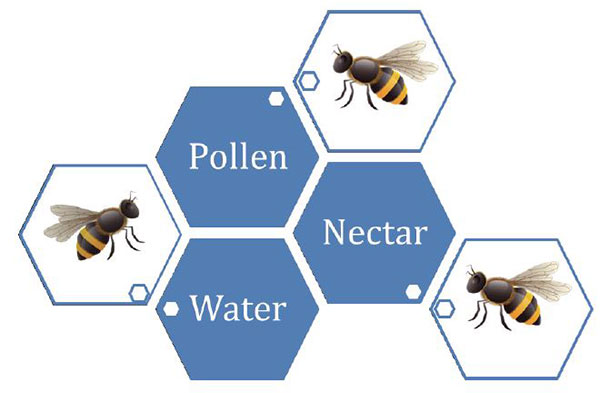
Pollen and nectar are the source of protein and carbohydrates for the developing brood in the hive. Nutritional requirements for a honey bee colony changes depending on the season. During the spring and summer seasons when the colony is actively growing, honey bees require a mixture of pollen and nectar. Pollen is the protein source necessary to maintain healthy larval development. Availability of pollen ensures that honey bee foragers progress normally through the age-based division of labor from young nurses to middle-aged builders to old foragers. Lack of access to sufficient pollen breaks down the normal age-based task transitions, leading to colony failure. Prolonged pollen limitation can cause queens to stop egg laying.
During the fall and winter months, the colony is not actively growing but the bees need to generate enough heat to keep warm during cold winter days. Honey bees do not hibernate but instead form a tight cluster where the bees vibrate their wing muscles and shiver to generate warmth on the coldest of winter days. This requires a lot of carbohydrates and therefore it is important for the colony to have adequate stored honey and access to sugar solution to make it through the cold winters in Colorado.
Seasonal Differences in Feeding
Honey bee colonies are active and growing in the spring and summer seasons. In the winter season, the colonies do not produce new adult bees but remain active. So, the nutritional requirements vary between seasons. It is important to understand the different feeding requirements associated with each season to sustain healthy colonies.
Colonies must have sufficient (80 – 100 pounds) stored honey going into the winter. In addition to this stored honey, feeding colonies during the winter months is common practice. Supplementing colonies with sugar solution (2 sugar: 1 water) in the early months of fall will give the bees enough time to ferment the syrup and turn it into honey reserves for the winter. In Colorado this is very important because the winters tend to be harsh. Forcing bees to delegate some of their energy to search for nectar instead of clustering decreases the hive’s chances of survival, as there are no flowers in the winter months.
In spring, supplemental feeding is seen as a measure to get the bees “back on their feet” to start foraging and get the colony growing. Colonies begin to consume more of their honey stores. Supplemental feeding in March is important as they begin to build their brood. After a long winter of buzzing around the queen to keep warm, the workers and newly-emerged drones can quickly exhaust available inhive honey reserves. Beekeepers can feed colonies with sugar solution (1 sugar: 1 water). Note the change in proportion of sugar to water from winter to spring feeding.
Spring feeding stimulates the foraging process and gives the bees enough energy to forage for naturally available pollen and nectar from flowers. Bees collect pollen from early blooming spring plants including crocus, hyacinth etc. Bees can also be seen collecting pollen from sugar maple, ash and other early blooming, wind-pollinated trees. Dandelions are one of the early blooming spring flowers that is a bone of contention among gardeners and beekeepers. Bees prefer other flowers over dandelions but will forage from dandelions in the absence of better food sources (Larson et al., 2014). Provide alternate early flowering plants (Factsheet 5.616) or supplement pollen to the hive to reduce bee activity on dandelions in regions when dandelions are actively being controlled by herbicide application.
During spring, with longer days and the warming temperatures, bees can be seen collecting water from any nearby sources including creeks, pools and bird baths. Provide water near the hives to reduce their time spent searching for water (Factsheet 5.615).
Sugar Feeds
Sugar is an integral part of the nutritional health of every honey bee colony. In order to ensure that the colony is well fed, beekeepers need to evaluate the health of the hive regularly (once a month) and ensure the presence of enough stored honey or nectar. A hive suffering from lack of sugar may exhibit a smaller and weaker population of bees. Such hives are generally found in areas with little or no flowering plants. It is important for every beekeeper to keep a seasonal record of what is blooming near the hive and the apiary from spring to fall. This will help the beekeeper determine periods when there is nothing in bloom and supplement the hive with sugar and pollen. Sugar supplementation can be done as sugar syrup, dry food, fondant or soft candy.
Beekeepers use sugar syrups to supplement the hive. The syrup is made by adding granulated sugar to lukewarm water, in a ratio dependent on the season, and shake vigorously to dissolve. Do not boil the water to dissolve the sugar. Do not use brown sugar, molasses or raw sugar in syrup for honey bees. There are several research findings that demonstrate that corn syrup is not a healthy option for bees.
Syrup Feeders

Plastic pail feeder with lid
Plastic Pail Feeder
Consists of a plastic or glass bucket with holes in the upper outer lip that delivers a pool of sugar syrup when turned upside down. This device can be placed inside or outside of the hive allowing the bees to perch on the lip and feed from the pool. Placing it inside the hive is a good option for both summer and winter feeding. One of the disadvantages of this kind of feeder is that it increases the risk of drowning of bees when sugar flows down and accumulates at the base of the hive. Locating it outside of the hive reduces such risk but may cause robbing from other colonies or animals nearby.
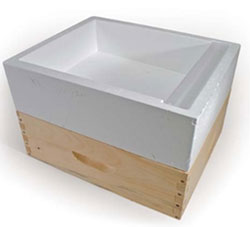
Hive Top Feeder
Hive Top Feeder
This consists of a plastic super placed on top of the hive that allows bees to climb into and feed from the syrup inside. This feeder is equipped with a metal frame or jagged plastic edges that allow the bee to maintain traction while feeding. Fatal drowning of the bees is still a risk with this method of feeding.
Division Board Feeder
This feeder is located within the hive and is a frame-sized box with rigid edges containing syrup. They come with a floating strip for bees to perch on while drinking the syrup. This feeder is highly prone to bee fatality as bees often drown from losing traction on the edges. The feeder location is fixed and sometimes bees may starve in the winter due to the feeder’s location in relation to the cluster.
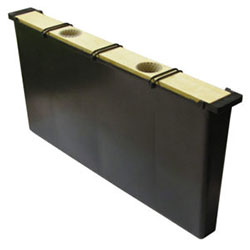
Division board feeder
Boardman Feeder
This feeder is external to the hive and uses a small plastic or wooden insert that holds an inverted mason jar with sugar syrup. The jar is fixed with a perforated metal top that the bees can feed from. Although it may provide the easiest access without disturbing the hive, the Boardman feeder is still predisposed to a series of issues that may affect the wellbeing of the hive. Problems may arise from exposure to light, incidence of diseases as well as freezing in the winter months, inducing starvation on a dependent hive. This hive feeding method is suggested because it reduces robbing by neighboring hives, and with proper management, can be the best method for
honey supplementing.
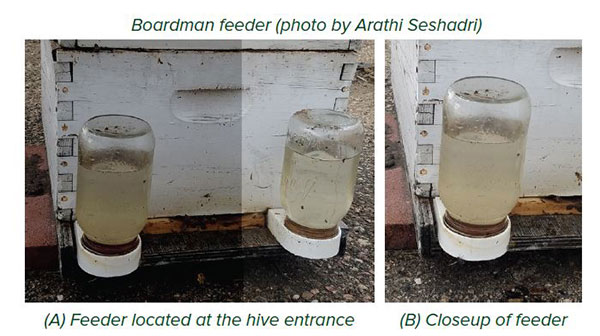
Plastic Bag Feeders
These are the least expensive alternatives to the use of an empty drawn comb. They require a gallon sized Ziploc bag filled 2/3rd with syrup. Carefully squeeze out most of the air and zip the bag closed. Carefully place the bag on the frames within the super. Make shallow ‘X’ slit after placing the bag on the frame. The syrup will not flow out, but the bees will immediately gather up at the slit. Do not cut too deep as you may slit the bottom as well.
Empty Drawn Comb
Using empty drawn combs to feed a hive may be the least invasive feeding method. This method requires an empty frame that may be submerged in a syrup solution and placed into the hive. It should only be used in cases of emergency when other feeding options are not available
because it has an increased risk of brood diseases, as combs retain spores and other infectious agents. It is important to ensure that empty drawn combs are obtained from a healthy colony.
Dry Sugar
In places where there is an abundance of freshwater available to the colony, dry sugar may be an alternative sugar solution supplementation. Unaltered dry granulated cane sugar (no heating or adding water) can be introduced through the bottom of the hive box or the top. When using this method, the placement of the sugar is key. Ways to reduce the chance of robbing or contamination include placing it furthest away from the entrance on the back-wall base or near the oblong hole located on top of the inner cover.
Fondant
This sugar supplement also known as invert sugar, can be created by mixing two cups of sugar, two tablespoons of corn syrup, and 1½ cups of boiling water. After combining and cooling, the fondant mixture is solidified by vigorously stirring the mixture until a soft clay-like ball is formed. This can be placed into a hive like a pollen patty, on top of the frames or at the bottom of a super. The fondant
reduces robbing from neighboring hives or wasps within the area and is a good source of sugar when water resources are high. Preparation of fondant uses a small amount of corn syrup.
Pollen
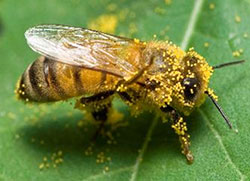
Pollen grains on the hairs of the honey bee (photo by Bruce Leander)
Pollen is another essential ingredient for the health of a hive. Worker bees obtain it through foraging on flowers. Pollen accumulates on the body hairs and legs of the bees. Bees stop during a foraging trip, groom all the pollen off their body and stuff the grains into pollen baskets or corbiculae on their hind legs. They return to flowers and continue the process. Once the pollen baskets are full, worker bees return to the hive, where they are unloaded, and the unloader bee stores the pollen pellet in cells as food reserves to use as feed for developing larvae.
Pollen from flowers is the primary source of protein for developing larvae and can be detrimental to a colony when there is a shortage. Pollen shortage results in bees foraging earlier in the life span and reduces their longevity as adults.
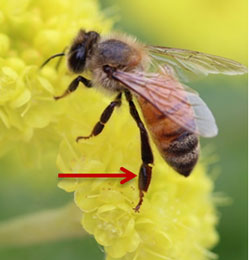
Pollen basket (corbicular) on the hind leg of a honey bee. (photo by Lisa Mason)
Bee larvae reared under pollen shortage grow up to be poor communicators as adults often making errors in the dance language describing the location of the flower patch (Scofield and Mattila 2015). Pollen is also an important ingredient in bee bread. Bee bread is composed of fermented pollen which the bees use throughout their active and inactive seasons.
When storing the reserves, bees will coat the bread with a fine layer of wax and honey. It, along with honey, is vital to the sustainability of a hive over the harsh winter seasons. To ensure that bee bread is present in the hive, beekeepers introduce pollen patties or other pollen substitutes in surplus for colonies to feed on.
Pollen patties are a good pollen substitute often containing pollen and clean honey that is worked into a disc and then heated to combine. Though honey bees prefer fresh pollen, protein substitutes and supplements can provide nutrients during periods of pollen dearth.

Honey bee with pollen baskets filled with pollen. (photo by Lisa Mason)
Additional nutritional compounds:
In addition, the pollen and nectar also provide small amounts of other chemical compounds, collectively known as “phytochemicals” or plant secondary metabolites. “Phytochemicals” are chemical compounds produced by plants mainly to defend themselves from pathogens and pests. Bees have a longstanding mutualism with plants and the relationship has evolved over evolutionary time scale. This relationship has resulted in bees benefiting from some of the plant defense compounds which extend their lifespan and promote disease tolerance (Bernklau et al. 2019). Access to these phytochemicals is dependent on a diverse array of flowering plants. Lack of certain phytochemicals due to a decline in plant diversity in the habitat can result in honey bee colonies becoming susceptible to pests and diseases.
| Season | Sugar | Pollen | Water |
|---|---|---|---|
| Spring (March – May) |
Yes Stimulate colony growth. 1 sugar : 1 water |
Yes Pollen patties to stimulate foraging |
Yes Fountains, bird baths, water dishes etc. |
| Summer (June – Aug) |
Yes Feed as needed 1 sugar : 1 water |
Yes Feed often to maintain healthy and strong colonies |
Yes Bees need water to cool hives. Fountains, bird baths, water dish etc. |
| Fall (Sep – Oct) |
Yes Prepare colonies for winter 1 sugar : 1 water |
Yes for part of the time Pollen patties in September to raise winter bees. Withdraw patties in October |
Optional |
| Winter (Nov – Feb) |
Yes Feed thicker syrup 2 sugar : 1 water |
No | No |
Colorado beekeeping
Honey bees rely on floral diversity to maintain a healthy immune system. It is necessary for beekeepers in Colorado to feed supplements to their hives as Colorado landscapes are not always able to meet the dietary needs of honey bees. In Colorado there are large agricultural communities that focus on a single crop or series of crops, with little to no diverse bee forage. In addition, increased urbanization has reduced natural habitats requiring honey bee hives to become more and more dependent on the beekeeper to provide a continuous source of nutrition. If beekeeping is your hobby, make sure your bee pets have access to good nutrition in order to remain healthy.
Some good flowers that can provide nutritious diet are listed in the following fact sheets
References
- Bernklau, E., Bjostad, L., Hogeboom, A., Carlisle, A., Arathi, H.S., 2019. Dietary Phytochemicals, Honey Bee Longevity and Pathogen Tolerance. Insects 10, 14.
- Larson, J.L., Kesheimer, A.J., Potter, D.A., 2014. Pollinator assemblages on dandelions and white clover in urban and suburban lawns. Journal of Insect Conservation 18, 863-873.
- Scofield, H.N., Mattila, H.R., 2015. Honey bee workers that are pollen stressed as larvae become poor foragers and waggle dancers as adults. PLoS ONE 10, e0121731.
Image sources
Betterbee, Greenwich NY unless otherwise indicated





